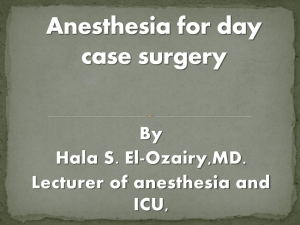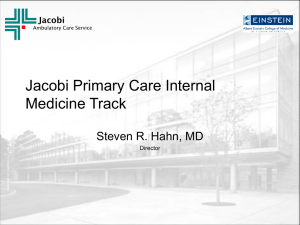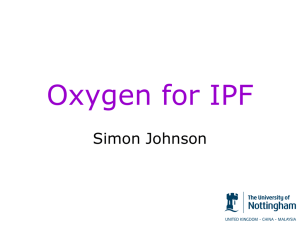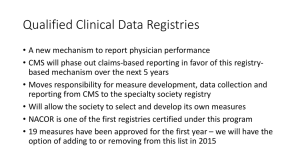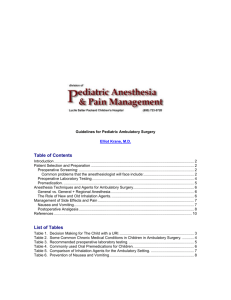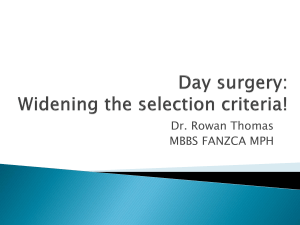Size: 735 kB - ambulatory anaesthesia mgmc
advertisement
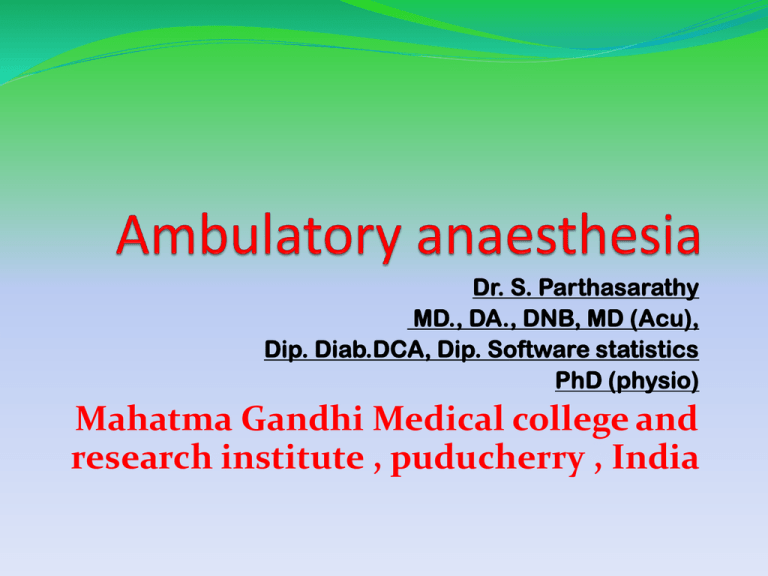
Dr. S. Parthasarathy MD., DA., DNB, MD (Acu), Dip. Diab.DCA, Dip. Software statistics PhD (physio) Mahatma Gandhi Medical college and research institute , puducherry , India Can we go about like that?? Definition Structure Set up Cases Anaesth technique PACU Definition ambulatory surgery “An operation/procedure, excluding an office or outpatient operation/procedure, where the patient is discharged on the same working day” Synonymous or different terms !! Is there a distinction distinction is to designate cases as outpatient when the patient is generally expected not to need any specialized care or specialized surveillance when the procedure is finished. ambulatory surgery has grown from less than 10% to over 70% of all elective surgical procedures SAMBA Recognized respected subspecialty occurred with establishment of the Society for Ambulatory Anesthesia (SAMBA) in 1984. the focus of ambulatory anesthesia is on the patient Patient preference, especially children and the elderly Lack of dependence on the availability of hospital beds Greater flexibility in scheduling operations • Low morbidity and mortality • Lower incidence of infection • Lower incidence of respiratory complications • Higher volume of patients (greater efficiency) • Shorter surgical waiting lists • Lower overall procedural costs • Less preoperative testing and postoperative medication Structure Unbelievable list Dental Extraction, restoration, facial fractures Dermatology Excision of skin lesions General Biopsy, endoscopy, excision of masses, hemorrhoidectomy, herniorrhaphy, laparoscopic cholecystectomy, adrenalectomy, splenectomy, varicose vein surgery Unbelievable list Gynecology Cone biopsy, dilatation and curettage, hysteroscopy, diagnostic laparoscopy, laparoscopic tubal ligations, uterine polypectomy, vaginal hysterectomy Ophthalmology Cataract extraction, chalazion excision, nasolacrimal duct probing, strabismus repair, tonometry Unbelievable list Otolaryngology Adenoidectomy, laryngoscopy, mastoidectomy, myringotomy, polypectomy, rhinoplasty, tonsillectomy, tympanoplasty Pain clinic Chemical sympathectomy, epidural injection, nerve blocks Unbelievable list Plastic surgery Basal cell cancer excision, cleft lip repair, liposuction, mammoplasty (reductions and augmentations), otoplasty, scar revision, septorhinoplasty, skin graft Urology Bladder surgery, circumcision, cystoscopy, lithotripsy, orchiectomy, prostate biopsy, vasovasostomy, laparoscopic nephrectomy and prostatectomy Unbelievable list Orthopedic Anterior cruciate repair, knee arthroscopy, shoulder reconstructions, bunionectomy, carpal tunnel release, closed reduction, hardware removal, manipulation under anesthesia and minimally invasive hip replacements BUT !! Thats the hitch !! duration of surgery in the ambulatory setting was originally limited to procedures lasting less than 90 minutes Previously ASA I and II but III also in some instances Plan 1- 3 weeks prior Ambulatory surgery ?? major postoperative surgical complications major fluid shifts procedures requiring prolonged immobilization and parenteral opioid analgesic therapy ambulatory patient-controlled analgesic techniques (e.g., subcutaneous, intranasal, transcutaneous), is allowing more patients undergoing painful orthopedic procedures to be discharged home on the day of surgery. Definite NO 1. Potentially life-threatening chronic illnesses (e.g., brittle diabetes, unstable angina, symptomatic asthma) 2. Morbid obesity complicated by symptomatic cardiorespiratory problems (e.g., angina, asthma) 3. Multiple chronic centrally active drug therapies (MAOIs) 4. Ex-premature infants less than 60 weeks’ postconceptual age requiring general endotracheal anesthesia 5. No responsible adult at home to care for the patient on the evening after surgery SONIA – pneumonic Specific situations Hypertension newly discovered hypertension or very high values or unstable high values should be evaluated and optimized before being scheduled for ambulatory care. Patients with arrhythmia, heart block, or a pacemaker, heart failure – better to avoid Diabetes mellitus Diabetic patients may be unsuitable for ambulatory care if they have some of the more serious complications of prolonged diabetes, namely cardiovascular disease, kidney failure, neuropathy, and morbid obesity. Drug abuse Body builders – OK But alcohol – consider nutrition , LFT and type of surgery Psychiatric patients, patients with cognitive dysfunction or disabilities usually benefit from having as short and uneventful stay in the hospital environment as possible More at home But no to any acute illness Pregnancy – second trimester preferable surgery should be ambulatory or not will depend not on the pregnancy per se but on the patient’s general condition and comorbidities. Breastfeeding is fully compatible with any surgery or anesthetic- ambu – ok Liver and kidney disease Acute illness Dialysis prior LFT results INR Type of surgery Thyroid Airway hyperthyroidism Doubt for ambulatory surgery Other systemic illness Rheumatoid arthritis, Bechterew disease (ankylosing spondylitis), and other rheumatic conditions These patients will usually be eligible for ambulatory care if they have no other major comorbidity. Other systemic illness Problems with previous anesthetics or with anesthesia in close family Beware and analyse Myaesthenia – avoid Personnel Anaesth + staff + nurse anaesth Surgeon only local small cases Monitors noninvasive blood pressure monitoring, electrocardiography (ECG), pulse oximetry, capnography for all intubations, gas monitoring (both in and out of patients) of oxygen and all inhalational gases, alarms to alert to problems of gas delivery and a low oxygen content in the ventilation gas, and temperature monitoring. BIS In case of emergencies there must be fast access to a suction device, a self-expanding ventilation bag with reservoir and extra oxygen supply, a defibrillator and emergency drugs intubation kit including devices for difficult intubations. Consent for ambulatory surgery A general rule is that the patient should consent to being sent home Journey time – not much decisive In patients with drug, alcohol, or substance abuse or who have an unstable social situationindividual decisions Preanaesthesia Can have an OPD consultation with anaesth Upto 3 months valid usually Healthy patients can go for spot assessment As a part of an inpatient hospital or alone Preop Fasting 6- 8 hours URI 6 weeks gap Premed – IV / oral midazolam ( not a must) Opioids pain and intubation response – Pethidine – antishivering acetaminophen, 40 mg/kg rectally, and ketorolac, 0.5 mg/kg intravenously. Antiemetic premed Principles two primary concerns for ambulatory anesthesia are speed of wake-up incidence of postoperative nausea and vomiting. Wake up time and discharge fit time !! Pharmacology Problems hypnotic, analgesic, and anti-nociceptive drugs have to be lipid soluble in order to penetrate the blood–brain barrier and reach their target cells in the central nervous system. distributed extensively into all other cells and tissues- cant go out thro kidneys brain and spinal cord have a large blood supply- hence more drugs – to be given general anesthesia, regional anesthesia, and local anesthesia In obstetrics, regional anesthesia, and local anesthesia are preferable In others all are acceptable Local patients who received local anesthesia also spent less time in the OR, had less postoperative pain, and the least problems with urination. Cost is less Spinal children aged 6 months to 14 years for procedures on the lower part of the body 0.5% hyperbaric bupivacaine at a dose of 0.2 mg/kg. Adults pencil point, noncutting tips ambulatory laparoscopic cholecystectomy Drugs Epidural and caudal Longer Difficult Failure Nerve blocks Nerve blocks improve postoperative patient satisfaction— PONV and postoperative pain are less. Costs are also less Paravertebral somatic nerve block can be used for breast surgery Perineural catheters in the sciatic nerve through the popliteal fossa Cont. femoral catheters Interscalene catheters . Post op pain relief General Anesthesia The popularity of propofol as an induction agent for outpatient surgery in large veins Suxa or rocuronium advised for paralysis An intubating dose of mivacurium (0.150.20 mg/kg) longer duration than suxa and better recovery Principles two primary concerns for ambulatory anesthesia are speed of wake-up incidence of postoperative nausea and vomiting. Wake up time and discharge fit time !! Agents propofol, sevoflurane, and desflurane Because of its extremely low tissue solubility, desflurane is associated with the most rapid recovery of both cognitive and psychomotor function Nitrous oxide : fast recovery , analgesia but PONV Pharmacologic antagonists antagonists frequently produce unwanted side effects (e.g., dizziness, headaches, nausea, vomiting). duration of action of the antagonist is shorter than the agonist (e.g., naloxone, flumazenil), a “rebound” agonist effect may occur later in the recovery period. Problem for ambulatory cases. specifically selective serotonin antagonists and acupuncture Nitrous Agents Opioids(fent- NSAIDs) Airways Supraglottic airway device especially LMA Cough Sorethroat Anas requirements But gastric sufflation and PONV PACU drowsiness, nausea and vomiting, pain. All three are a function of intraoperative management, but nausea, vomiting, and pain also can be treated in the PACU. Other problems anaesth and surgical Discharge from the postanesthesia care unit Phase 1 - discontinuation of anesthetic agents until the recovery of the protective reflexes and motor function phase 2 is the period during which the criteria for discharge from the ambulatory surgical unit (ASU) are obtained. phase 3 lasts for several days and continues until the patient is back to their preoperative functional status and is able to resume their daily activities modified Aldrete scoring system Activity: Able to move voluntarily or on command Respiration Circulation Consciousness O2 saturation Score of 10 – 8 or 9 is a must Recovery and discharge Scoring systems White and Song scoring system for fast track Experience explained Adults Is oral fluid intake necessary before discharge? If forced,higher incidence of vomiting and a prolonged hospital stay in children for adults, drinking did not infl uence the incidence of PONV or duration of hospital stay Drinking oral fluids is not a requirement prior to discharge Is voiding necessary before discharge? voiding is not a requirement before discharge Risks USG Is an escort needed following ambulatory surgery? ASA recommendations – must When can you drive following ambulatory surgery? Recently, a prospective study involving ambulatory surgery demonstrated that patients have lower alertness levels and impaired driving skills preoperatively and 2 hours postoperatively. These parameters returned to normal at 24 hours. Summary Definition Structure Cases and NO Premed and anaesthesia Recovery and PONV PACU Discharge controversies

